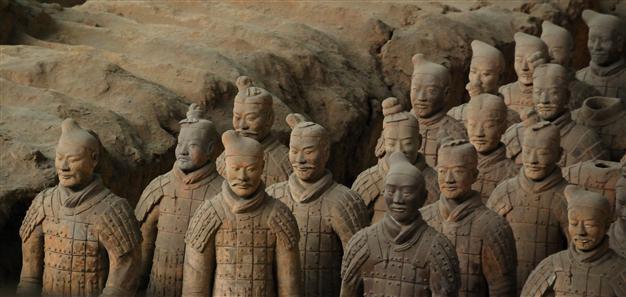China’s terracotta army has new recruits
XIAN

A large number of clay warriors, horses and chariots have been found buried near the tomb of China’s first emperor, Qin Shihaung, who founded the Qin Dynasty in 221 B.C. New excavations close to the tomb have revealed nearly 1,400 of the life-sized clay statutes.
Archaeologists have used digital scanning techniques at the enormous excavation in Xi’an, Shaanxi province in China. They estimate the pit, which is thought to have been where the army’s cavalry and archers were placed, also contains 89 war chariots along with statues of horses.
It is the first dig at the site since 2008, when activity was halted due to a lack of adequate personnel. Some of the most exquisite statues were uncovered during early work at the site, including a rare warrior with a green face.
The discovery suggested the army was once colorfully painted, but the pigments had faded over time.
Yuan Zhongyi, one of the archaeologists leading the project, said the pit contained the essence of the terracotta warriors due to the mix of figures there.
“You can find all the kneeling archers, soldiers and cavalry in the number two pit. Their colorful paint is also relatively well preserved,” he said, according to the China News Service.
The terracotta army was first discovered by accident in 1974 by farmers in the Lintong district of Xi’an. Archaeologists have uncovered four distinct pits, each around 23 feet deep – the largest of which contained 6,000 of the terracotta warriors.
The second pit is thought to contain the cavalry and archers, although only 120 figures have been uncovered so far.
The third pit contained the tallest figures, which are thought to be the generals and officers, while the fourth pit appears to have been left empty.
The army is thought to have been built to protect Emperor Qin Shihaung after his death and was positioned just under a mile east of his burial mound.
 A large number of clay warriors, horses and chariots have been found buried near the tomb of China’s first emperor, Qin Shihaung, who founded the Qin Dynasty in 221 B.C. New excavations close to the tomb have revealed nearly 1,400 of the life-sized clay statutes.
A large number of clay warriors, horses and chariots have been found buried near the tomb of China’s first emperor, Qin Shihaung, who founded the Qin Dynasty in 221 B.C. New excavations close to the tomb have revealed nearly 1,400 of the life-sized clay statutes.